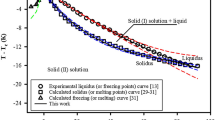Abstract
Equation-of state theories of Flory and of Sanchez and Lacombe describe both enthalpy and volume of mixing of binary systems using single component properties and only one binary parameter X12. We have evaluated this parameter from literature enthalpy data for numerous mixtures of two aromatic hydrocarbons, of alkanes with aromatic compounds, and of alkanes with carbonyl compounds. We have used this X12 for calculation of excess volumes and compared the results with our previously measured experimental data. The agreement was fair for mixtures of two nonpolar components. Nevertheless, mixtures containing either cyclohexane or benzene displayed anomalies that could be traced to special packing of molecules in these compounds when pure. For mixtures of carbonyl compounds with alkanes, the theories predicted the qualitative trends correctly, but the quantitative agreement was rather poor. These results tend to support a model in which the enthalpy(cohesive energy) is inversely proportional to volume (as in the theories considered) only for dispersive interaction. When polar-polar interactions are involved, the dependence of excess volume on the excess enthalpy is much weaker.
Similar content being viewed by others
References
P. Munk, P. Hattam, and Q. Du,J. Appl. Polym. Sci. Appl. Polym. Symp. 43, 373 (1989).
W. Cheng, A.-A. A. Abdel-Azim, M. J. El-Hibri, Q. Du, and P. Munk,J. Phys. Chem. 93, 8248 (1989).
A. Qin, D. E. Hoffman, and P. Munk,J. Chem. Eng. Data 37, 55 (1992).
A. Qin, D. E. Hoffman, and P. Munk,J. Chem. Eng. Data 37, 62 (1992).
A. Qin, D. E. Hoffman, and P. Munk,J. Chem. Eng. Data 37, 66 (1992).
P. J. Flory,Disc. Faraday Soc. 49, 7 (1970).
D. Pattterson and G. Delmas,Disc. Faraday Soc. 49, 98 (1970).
I. C. Sanchez and R. H. Lacombe,J. Phys. Chem. 80, 2352 (1976).
R. H. Lacombe and I. C. Sanchez,J. Phys. Chem. 80, 2568 (1976).
U. Cabrerizo, R. G. Rubio, C. Menduina, and J. A. R. Renuncio,J. Phys. Chem. 90, 889 (1986)
P. J. Flory,J. Am. Chem. Soc. 87, 1833 (1965).
H. T. Van and D. Patterson,J. Solution Chem. 11, 793 (1982).
M. Costas and B. C. Sanctuary,J. Phys. Chem. 85, 3153 (1981).
M. Costas and D. Patterson,J. Solution Chem. 11, 807 (1982).
R. F. Brunel and K. Van Bibber, inInternational Critical Tables, Vol. III, E. W. Washburn, ed., (McGraw-Hill, New York and London, 1928).
G. Tardajos, E. Aicart, M. Costas, and D. Patterson,J. Chem. Faraday Trans. I 82, 2977 (1986).
A. J. Treszczanowicz and G. C. Benson,Fluid Phase Equilibria. 23, 117 (1985).
T. M. Letcher and R. C. Baxter,J. Solution Chem. 18, 65 (1989).
A. Abe and P. J. Flory,J. Am. Chem. Soc. 87, 1838 (1965).
A. D. Matilla, E. Aicart, M. Diaz Peña, and G. Tardajos,J. Solution Chem. 18, 143 (1989).
B. D. Smith and R. Srivastava,Thermodynamic Data for Pure Compounds, A, Hydrocarbons and Ketones (Elsevier, New York, 1986).
R. C. Weast, ed.,CRC Handbook of Chemistry and Physics, 56th edn.,(CRC Press, 1975–76).
A. W. Francis,Chem. Eng. Sci. 10, 37 (1959).
G. Allen, G. Gee, and G. Wilson,Polymer 1, 456 (1960).
A.-A. A. Abdel-Azim and P. Munk,J. Phys. Chem. 91, 3910 (1987).
A. Weissberger, E. S. Proskauer, J. A. Riddick, and E. E. Toops, Jr,Organic Solvents. Physical Properties and Methods of Purification (Interscience, New York, 1955).
J.-P. E. Grolier, D. Ballet, and A. Viallard,J. Chem. Thermodyn. 6, 895 (1974).
P. Munk, P. Hattam, A. Abdel-Azim, and Q. Du,J. Appl. Polym. Sci. Appl. Polym. Symp. 48, 293 (1991).
J. Timmermans,Physico-Chemical Constants of Pure Organic Compounds, Vols. I and II (Elsevier, New York, 1950 and 1965).
J. J. Christensen, R. W. Hanks, and R. M. Izatt,Handbook of Heats of Mixing (Wiley, New York, 1982).
R. B. Grigg, J. R. Goates, J. B. Ott, and D. L. Thomas,J. Chem. Thermodyn. 14, 27 (1982).
C. Clement,J. Chim. Phys. 75, 745 (1978).
M.-E. Saint-Victor, A. J. Treszczanowicz, and D. Patterson,Fluid Phase Equilibria 46, 295 (1989).
A. Heintz,Ber. Bunsenges. Phys. Chem. 89, 172 (1985).
Author information
Authors and Affiliations
Rights and permissions
About this article
Cite this article
Pouchlý, J., Qin, A. & Munk, P. Excess volume of mixing and equation of state theories. J Solution Chem 22, 399–425 (1993). https://doi.org/10.1007/BF00647679
Received:
Revised:
Issue Date:
DOI: https://doi.org/10.1007/BF00647679




